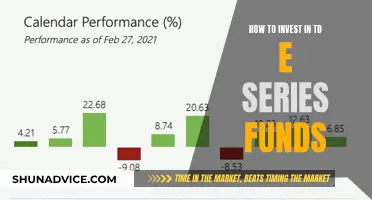
Investing in mutual funds is a popular option for those who want to diversify their portfolio without the time or expertise needed to choose individual stocks. Mutual funds pool money from multiple investors to purchase a range of assets, such as stocks or bonds, providing individual investors with access to a professionally managed portfolio.
When deciding which funds to invest in, it's important to consider your investment goals, risk tolerance, and time horizon. Different funds have different management styles, fees, and performance records, so it's crucial to research and evaluate them before investing. Diversification is key to long-term success, and mutual funds can help you achieve that by providing exposure to various assets and sectors.
| Characteristics | Values |
|---|---|
| Investment goals | Long-term capital gains, current income, college expenses, retirement |
| Risk tolerance | Dramatic swings in portfolio value, conservative investment |
| Time horizon | Short-term, long-term |
| Types of mutual funds | Stock funds, bond funds, target-date funds, money market funds, income funds, growth funds, capital appreciation funds |
| Management style | Active, passive |
| Fees | Front-end load, back-end load, expense ratio, 12b-1 fees, management expense ratio, load fee, redemption fees, account fees, transaction fees |
| Fund managers | Years of experience, ability to perform in good and poor market conditions |
| Fund performance | Long-term, short-term |
What You'll Learn

Define your goals and risk tolerance
Before investing in any fund, it is important to first identify your goals and risk tolerance. Ask yourself: What are your investment goals? What is your risk tolerance? How long do you plan to hold the fund?
Your investment goals will depend on your time horizon. For example, if you are investing for retirement 30 years in the future, you can opt for a more aggressive (stock-heavy) mutual fund. Generally, the shorter your time horizon, the more conservative your mutual fund should be. Longer-term investors can afford to take on more risk as they have time to wait out any stock market declines.
Your risk tolerance will depend on whether you are willing to tolerate large swings in your portfolio's value for the chance of greater long-term returns. If you are investing for retirement, it is typically best to keep your money invested for the long haul. However, if a very aggressive strategy makes you uncomfortable, it is best to adjust your strategy to suit your risk tolerance.
It is also important to consider the desired time horizon. Mutual funds have sales charges, which can eat into returns in the short run. Therefore, an investment horizon of at least five years is ideal.
Mutual Fund Investing: Cutting Out the Middleman
You may want to see also

Understand active vs passive fund management
There are two main investment strategies that can be used to generate a return on investment accounts: active and passive fund management. Active fund management involves a fund manager picking and choosing investments, with the goal of usually outperforming a specific benchmark or index such as the S&P 500. It requires in-depth research, market forecasting, and the expertise of the management team. Active funds strive for superior returns but take greater risks and entail larger fees.
On the other hand, passive fund management involves mimicking the investment holdings of a particular index, such as the S&P 500 or the Dow Jones Industrial Average, in order to achieve similar results. Passive funds are designed to parallel the returns of a market index as closely as possible. This strategy does not require a management team and can be structured as an exchange-traded fund (ETF), a mutual fund, or a unit investment trust (UIT). Passive funds have much lower fees than active funds, as they do not require extensive research and analysis.
Over the past decade, active funds have underperformed passive funds. However, active funds offer more flexibility, the ability to hedge against losses, and better risk and tax management. Passive funds, on the other hand, offer good transparency, low fees, and tax efficiency.
When deciding between active and passive fund management, investors should consider costs, time horizons, and risk appetite. Passive funds tend to be better for easily traded, well-known holdings, while active funds can perform better in niche markets where there is less liquidity and fewer people watching.
Large-Cap Index Funds: A Smart Investment Strategy
You may want to see also

Research fund managers and past results
When deciding which funds to invest in, it is important to research fund managers and their past results. Fund managers are highly trained professionals who use publicly available information to make investment decisions. They often have a team of analysts who use specialised software to analyse companies, markets, and economic variables. While fund managers have access to more resources than the average investor, their conclusions are not necessarily better.
When evaluating fund managers, it is important to consider their qualifications, experience, and track record. Many fund managers have a Chartered Financial Analyst (CFA) designation, which requires rigorous standardised testing and adherence to a code of ethics. In addition, fund managers should have a strong understanding of macroeconomics, international trade, and behavioural finance.
It is also important to look at the fund's past performance and compare it to its benchmark. Has the fund consistently beaten the market? What level of volatility has the fund experienced? What has been the turnover rate, and has this created taxable events?
Another key consideration is the fund's management style. Is it actively or passively managed? Actively managed funds involve the fund manager buying and selling securities with the goal of outperforming a benchmark index. These funds tend to have higher fees to compensate for the fund manager's time and expertise. On the other hand, passively managed funds aim to replicate the performance of a specific index, resulting in lower fees.
When researching fund managers, it is essential to consider their investment strategy, performance history, qualifications, and management style. By evaluating these factors, you can make a more informed decision about which funds to invest in.
A Guide to Mutual Fund Investing in America
You may want to see also

Compare fees and overall costs
Fees and overall costs are an important consideration when choosing a mutual fund to invest in. Mutual funds are run by fund managers, who conduct research and choose the fund's securities based on their investing strategy. Fund managers are compensated for their time, and these fees can be high. Therefore, it is important to be conscious of fees as they can greatly impact your investment returns.
There are several types of fees associated with mutual funds. Some funds charge a sales fee, or a "load", which is either charged at the time of purchase or upon the sale of the investment. A front-end load fee is paid out of the initial investment when you buy shares in the fund, while a back-end load fee is charged when you sell your shares. Back-end load fees typically apply if the shares are sold before a set time, usually five to ten years from the purchase date. These fees are intended to deter investors from buying and selling too often and can be as high as 8.5% by law.
Other fees to look out for include 12b-1 fees, which are used for promotions, sales, and other activities related to the distribution of fund shares. These fees are baked into the share price and may not be obvious to investors. By law, 12b-1 fees can be as high as 1% of your investment in the fund.
The expense ratio is the total percentage of fund assets that are being charged to cover fund expenses. The higher the ratio, the lower the investor's return will be at the end of the year. According to a recent report, the average expense ratio for actively managed equity funds was 0.65% in 2023. In comparison, the average for index funds was 0.05%.
When considering fees and overall costs, it is also important to evaluate the fund's management style. Actively managed funds have portfolio managers who make decisions about which securities and assets to include in the fund, and these funds often have higher fees. On the other hand, passively managed funds, or index funds, seek to track and duplicate the performance of a benchmark index and generally have lower fees.
In summary, when comparing fees and overall costs of mutual funds, it is important to consider the different types of fees, the expense ratio, and the management style of the fund. By law, load fees can be as high as 8.5%, and 12b-1 fees can be as much as 1% of your investment. The expense ratio will impact your returns, with higher ratios resulting in lower returns. Actively managed funds tend to have higher fees than passively managed funds.
Invest in Berkshire Hathaway: A Guide to Buffett's Fund
You may want to see also

Diversify your portfolio
Diversifying your portfolio is one of the most effective ways to ensure long-term outperformance and stability. Total stock market funds, which own tiny pieces of every publicly traded company, are a great way to diversify your portfolio. This is because an all-encompassing fund can add diversity to your portfolio. If a crisis affects an entire industry, spreading your money across sectors mitigates the risk.
You can also choose to invest in international funds, bonds, real estate, fixed-income funds, and other types of assets to create a more well-rounded portfolio with lower volatility.
Mutual funds are a great way to diversify your portfolio. They are ideal for investors who don't have the time or ability to choose stocks. With mutual funds, you can turn the selection of individual stocks, bonds, and other investments over to professionals. Mutual funds are also actively managed by fund managers who conduct research and choose the fund's securities based on their investing strategy.
There are thousands of mutual funds to choose from, but not all of them will be a good fit. Consider your investing goals and risk tolerance before buying. If you are investing for retirement, it is typically best to keep your money invested for the long haul.
If you need to access your money in less than five years, an aggressive growth fund is likely not the best strategy. A target-date fund is a good example of a fund that has the time horizon already built in. This type of fund adjusts its risk level based on how close you are to retirement age.
There are also different types of mutual funds to choose from, including large-cap funds, small-cap funds, value funds, and growth funds. Large-cap funds invest in large, widely held companies with market capitalizations usually worth $10 billion or more. Small-cap funds tend to invest in companies with market capitalizations between $300 million and $2 billion. Value funds consist of stocks that are perceived to be undervalued, while growth funds invest in companies with high growth potential.
It is also important to be conscious of fees when choosing a mutual fund, as they can greatly impact your investment returns. Some funds have front-end load fees, while others have back-end load fees. Front-end load fees are charged when you buy shares, and back-end load fees are charged when you sell your shares. Other funds are no-load funds, which have no load fees.
Energy Funds: A Smart Investment for Your Future
You may want to see also
Frequently asked questions
Before investing in mutual funds, it's crucial to consider your financial goals, risk tolerance, time horizon, and the fees involved. Ask yourself whether you want steady growth or higher potential returns and if you can tolerate large swings in your portfolio's value. Additionally, determine how long you plan to invest, as mutual funds have sales charges that can impact short-term returns.
When evaluating a mutual fund's performance, focus on its long-term results and compare them against other funds investing in similar areas of the market. While short-term performance can be considered, it may not be as indicative of the fund's future prospects. It's also essential to assess the fund's managers, their experience, and their ability to deliver results consistent with market returns.
Mutual funds can be categorized into several types, including bond funds, equity funds, target-date funds, and money market funds. Each type has distinct investment profiles, risk levels, performance results, and fees. Your personal investment goals and risk tolerance will help determine which type of fund is most suitable for you.
Mutual funds typically carry various fees, such as sales loads (front-end or back-end), redemption fees, exchange fees, account fees, and annual operating expenses. It's important to carefully review the fund's prospectus to understand the breakdown of these costs, as they can impact your overall returns.
You can purchase shares of a mutual fund through a broker or directly from the fund itself. Start by obtaining and reviewing the fund's prospectus to ensure it aligns with your investment objectives. If it meets your criteria, you can proceed to make the investment through your broker or the fund.







